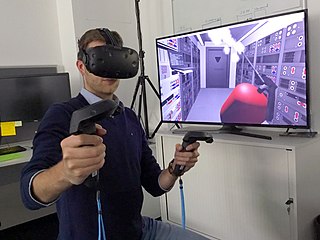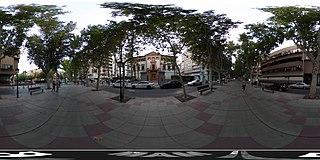
Virtual reality (VR) is a simulated experience that can be similar to or completely different from the real world. Applications of virtual reality can include entertainment and educational purposes. Other, distinct types of VR style technology include augmented reality and mixed reality, sometimes referred to as extended reality or XR.

A panorama is any wide-angle view or representation of a physical space, whether in painting, drawing, photography, film, seismic images or a three-dimensional model. The word was originally coined in the 18th century by the English painter Robert Barker to describe his panoramic paintings of Edinburgh and London. The motion-picture term panning is derived from panorama.
Panoramic photography is a technique of photography, using specialized equipment or software, that captures images with horizontally elongated fields of view. It is sometimes known as wide format photography. The term has also been applied to a photograph that is cropped to a relatively wide aspect ratio, like the familiar letterbox format in wide-screen video.
QuickTime VR is an image file format developed by Apple Inc. for QuickTime, and discontinued along with QuickTime 7. It allows the creation and viewing of VR photography, photographically-captured panoramas, and the exploration of objects through images taken at multiple viewing angles. Supported up to the discontinued QuickTime version 7, QuickTime VR functions as a plugin for the standalone QuickTime Player, as well as working as a plugin for the QuickTime Web browser plugin.
Panorama Tools(also known as PanoTools) are a suite of programs and libraries for image stitching, i.e., re-projecting and blending multiple source images into immersive panoramas of many types. It was originally written by German physics and mathematics professor Helmut Dersch. Panorama Tools provides a framework An updated version of the Panorama Tools library serves as the underlying core engine for many software panorama graphical user interface front ends.

Hugin is a cross-platform open source panorama photo stitching and HDR merging program developed by Pablo d'Angelo and others. It is a GUI front-end for Helmut Dersch's Panorama Tools and Andrew Mihal's Enblend and Enfuse. Stitching is accomplished by using several overlapping photos taken from the same location, and using control points to align and transform the photos so that they can be blended together to form a larger image. Hugin allows for the easy creation of control points between two images, optimization of the image transforms along with a preview window so the user can see whether the panorama is acceptable. Once the preview is correct, the panorama can be fully stitched, transformed and saved in a standard image format.
PTGui is a panorama photo stitching program for Windows and macOS developed by New House Internet Services BV. PTGui was created as a GUI frontend to Helmut Dersch's Panorama Tools. It features its own stitching and blending engine along with compatibility to Panorama Tools. PTGui supports telephoto, normal, wide angle and fisheye lenses to create partial cylindrical up to full spherical panoramas. PTGui can handle multiple rows of images.

Photosynth is a discontinued app and service from Microsoft Live Labs and the University of Washington that analyzes digital photographs and generates a three-dimensional model of the photos and a point cloud of a photographed object. Pattern recognition components compare portions of images to create points, which are then compared to convert the image into a model. Users are able to view and generate their own models using a software tool available for download at the Photosynth website.

360-degree videos, also known as immersive videos or spherical videos, are video recordings where a view in every direction is recorded at the same time, shot using an omnidirectional camera or a collection of cameras. During playback on normal flat display the viewer has control of the viewing direction like a panorama. It can also be played on a displays or projectors arranged in a sphere or some part of a sphere.

VR photography is the interactive viewing of wide-angle panoramic photographs, generally encompassing a 360-degree circle or a spherical view. The results is known as VR photograph, 360-degree photo, photo sphere, or spherical photo, as well as interactive panorama or immersive panorama.
CleVR is a free panoramic photo sharing site and photo stitching software. It allows panoramas to be embedded into other web pages using a Flash viewer. Panoramas can be displayed with hotspots — areas in the scene that can be clicked to display other content or to navigate to another scene. This functionality is similar to that provided by Apple's QuickTime VR, but it allows images, text and Flash Video (FLV) video to be displayed within the panorama window.

In photography, an omnidirectional camera, also known as 360-degree camera, is a camera having a field of view that covers approximately the entire sphere or at least a full circle in the horizontal plane. Omnidirectional cameras are important in areas where large visual field coverage is needed, such as in panoramic photography and robotics.
Photo stitching software produce panoramic pictures and VR photographs. The other method involves using panoramic cameras or panoramic mirror lenses.

Malwarebytes is an anti-malware software for Microsoft Windows, macOS, Chrome OS, Android, and iOS that finds and removes malware. Made by Malwarebytes Corporation, it was released in January 2006. It is available in a free version, which scans for and removes malware when started manually, and a paid version, which additionally provides scheduled scans, real-time protection and a flash-memory scanner.

Oculus Rift is a line of virtual reality headsets developed and manufactured by Oculus VR, a division of Facebook Inc., released on March 28, 2016.

Google Cardboard is a virtual reality (VR) platform developed by Google. Named for its fold-out cardboard viewer into which a smartphone is inserted, the platform is intended as a low-cost system to encourage interest and development in VR applications. Users can either build their own viewer from simple, low-cost components using specifications published by Google, or purchase a pre-manufactured one. To use the platform, users run Cardboard-compatible mobile apps on their phone, place it into the back of the viewer, and view content through the lenses.

Open Source Virtual Reality (OSVR) is an open-source software project that aims to enable headsets and game controllers from all vendors to be used with any games developed by Razer and Sensics. It is also a virtual reality headset that claims to be open-source hardware using the OSVR software.

VSDC Free Video Editor is a non-linear editing (NLE) application developed by Flash-Integro, LLC. The program is capable of processing high-resolution footage including 4K UHD, 3D and VR 360-degree videos. VSDC allows for applying post production effects, live color correction, and motion tracking. It supports VirtualDub plug-ins as well as the ability to capture video from screen, record voice, save multimedia files to numerous formats including those pre-configured for publishing on Facebook, Vimeo, YouTube, Instagram, and Twitter.

RoundMe is a virtual tour application which allows users to create, upload and share 360 degree panoramic photos and multimedia content of real spaces, that users could visit virtually using Google Cardboard or any VR headsets. The app is available on the web, iOS and Android. Roundme was positioned as one of the Best New Apps in the iTunes App Store in 58 countries in 2015. Roundme raised a $3 million round led by April Capital in 2015, reportedly by TechCrunch. The company is also hosting spaces for brands including National Library of Belarus and American Airlines.
Live Home 3D is a virtual home design software for macOS, Windows 10 computers and iOS.













